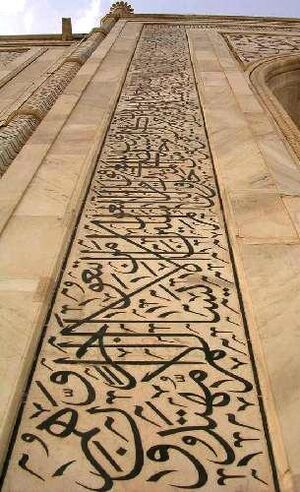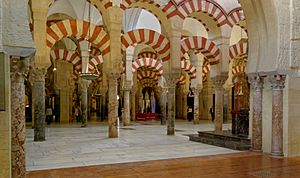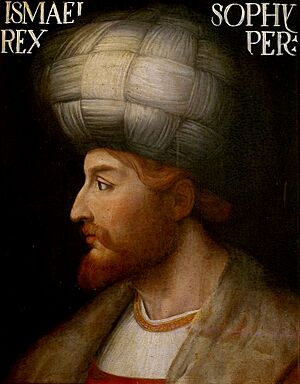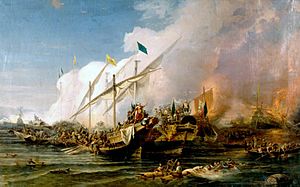List of Muslim states and dynasties facts for kids
This article is about the history of Islamic states and Muslim dynasties. These are groups of people who ruled over areas, often for a long time, and followed the religion of Islam. Their story begins with the Islamic prophet Muhammad (570–632 CE) and the early Muslim conquests that helped Islam spread beyond the Arabian Peninsula. This history continues right up to today.
The very first Islamic government was set up by Muhammad in the city of Medina in 622 CE. After he passed away in 632 CE, his closest followers created the Rashidun Caliphate.
Later, many powerful Muslim dynasties rose. Some of these groups built huge and famous empires. These include the Umayyad Empire, the Abbasid Empire, the Ottoman Empire (which was based around Anatolia, modern-day Turkey), the Safavid Empire in Persia, and the Mughal Empire in India.
Contents
- Biggest Muslim Empires by Land Area
- Major Muslim Dynasties by Region
- See also
Biggest Muslim Empires by Land Area
Here's a look at some of the largest Muslim empires based on how much land they controlled. These empires were huge, covering many countries that exist today!
Major Muslim Dynasties by Region
Muslim dynasties and states have existed all over the world. Here are some of the most important ones, grouped by where they were located.
Middle East and North Africa
This region is where Islam first began. Many powerful empires rose and fell here.
- Umayyad caliphate (661–750): This caliphate was based in Damascus, Syria. It was one of the largest empires ever.
- Abbasid caliphate (750–1258): Based in Baghdad, Iraq, this caliphate was known for its golden age of learning and science.
- Ayyubid dynasty (1171–1341): This dynasty was famous for its leader, Saladin, who fought during the Crusades.
- Mamluk Dynasty (1250–1517): These rulers were originally slave soldiers who rose to power in Egypt and Syria.
- Ottoman Empire (1299–1922): A huge empire that lasted for centuries, ruling over much of the Middle East, North Africa, and parts of Europe.
Arabian Peninsula and Persian Gulf
This area is the birthplace of Islam. Many local states and larger empires controlled this region.
- Rashidun Caliphate (632–661): The first caliphate after Prophet Muhammad.
- Emirate of Diriyah (1744–1818): This was the first Saudi State.
- Kingdom of Saudi Arabia (1932–present): The modern state of Saudi Arabia.
- Omani Empire (1696–1856): A powerful empire that controlled trade routes in the Indian Ocean.
North Africa (Algeria, Egypt, Libya, Morocco, Tunisia)
North Africa saw many different Muslim rulers, often connected to Spain and the Middle East.
- Fatimid Caliphate (909–1171): This caliphate ruled across North Africa and parts of the Middle East.
- Almoravid dynasty (1040–1147): A powerful empire that spread across North Africa and into Spain.
- Almohad dynasty (1121–1269): Another strong empire that followed the Almoravids in North Africa and Spain.
- Alaouite dynasty (1631–present): The current ruling family of Morocco.
- Mamluk dynasty (1250–1517): Also ruled Egypt, as mentioned above.
Horn of Africa
This region, including modern-day Somalia, Ethiopia, Eritrea, and Djibouti, had many sultanates and kingdoms.
- Ajuran Sultanate (1300–1798): A powerful Somali sultanate known for its strong trade and building projects.
- Adal Sultanate (1415–1555): An important Muslim state in the region that often fought with Christian Ethiopia.
- Sultanate of Aussa (1734–present): An ongoing sultanate in Ethiopia.
Persian Plateau and Anatolia
This area includes modern-day Iran and Turkey, which were home to some of the most influential Muslim empires.
- Safavid dynasty (1502–1736): A very important empire in Persia (Iran) that established Shia Islam as the official religion.
- Ottoman Empire (1299–1923): As mentioned before, this massive empire was centered in Anatolia (Turkey).
- Great Seljuq Empire (1029–1194): A large Turkic empire that controlled vast areas of the Middle East and Central Asia.
- Ilkhanate (1295–1357): A Mongol-led empire that adopted Islam and ruled Persia.
Indian Subcontinent
Islam arrived in the Indian subcontinent through trade and conquests, leading to several powerful Muslim states.
- Delhi Sultanate (1206–1526): A series of Muslim dynasties that ruled over large parts of India from Delhi.
- Mughal Empire (1526–1857): One of the wealthiest and most powerful empires in Indian history, known for its amazing architecture like the Taj Mahal.
- Bengal Sultanate (1352–1576): A significant independent Muslim kingdom in Bengal (modern-day Bangladesh and parts of India).

Southern Europe
Muslim rule in Europe was mostly in Spain and Portugal, known as Al-Andalus.
- Emirate of Cordoba (756–929) and Caliph of Cordoba (929–1031): These were powerful Muslim states in Spain, known for their advanced culture and learning.
- Emirate of Sicily (802–1091): A Muslim state on the island of Sicily, Italy.

Sahel and Sub-Saharan Africa
Islam spread across the Sahara Desert into West and East Africa, leading to the rise of many powerful kingdoms and empires.
- Mali Empire (1230–1670): A very rich and powerful empire in West Africa, famous for its gold trade and city of Timbuktu.
- Songhai Empire (1340–1591): Another large West African empire that followed the Mali Empire.
- Bornu Empire (1380–1893): A long-lasting empire in Central Africa.
- Sokoto Caliphate (1804–1903): A large Islamic state in West Africa, founded by Usman dan Fodio.
East Africa ("Swahili Coast")
Along the coast of East Africa, trade with Arab merchants led to the growth of many independent Muslim city-states.
- Kilwa Sultanate (957–1517): A major trading power on the Swahili Coast.
- Sultanate of Zanzibar (1856–1964): An important sultanate that controlled trade in the region.
Indian Ocean Region
Islands in the Indian Ocean also saw the rise of Muslim states.
- Sultanate of Maldives (1153–1968): A long-lasting sultanate on the Maldives islands.
- Sultanate of Ngazidjia (1400–1912): One of several sultanates in the Comoros islands.
Eastern Europe (Balkan Region) and Ural Region, Siberia (Russia)
Muslim states also existed in parts of Eastern Europe and Russia.
- Crimean Khanate (1441–1783): A Turkic Muslim state in Crimea, Ukraine.
- Ottoman Empire (1299–1922): Also ruled over much of the Balkans.
- Golden Horde (1251–1502): A Mongol-led state in Russia that adopted Islam.
- Kazan Khanate (1438–1552): A Turkic Muslim state in what is now Russia.
Central Asia, East Asia
Central Asia was a crossroads for many empires, and Islam became very important there.
- Karakhanid Empire (840–1212): A Turkic Muslim state in Central Asia.
- Timurid dynasty (1370–1507): Founded by Timur (Tamerlane), this empire was known for its art and science.
- Khanate of Bukhara (1500–1785): An important khanate in Uzbekistan.
- Yarkent Khanate (1514–1705): A Muslim state in what is now Xinjiang, China.
Southeast Asia
Islam spread to Southeast Asia through trade, leading to many sultanates, especially in Indonesia, Malaysia, and the Philippines.
- Malacca Sultanate (1400–1511): A very important trading empire in Malaysia.
- Aceh Sultanate (1496–1904): A powerful sultanate on the island of Sumatra, Indonesia.
- Bruneian Sultanate (1363–present): The long-lasting sultanate of Brunei.
- Sultanate of Sulu (1405–1915): A significant Muslim state in the southern Philippines.

See also
- List of Sunni dynasties
- List of Shia dynasties
- Islamic state
- Caliphate
- List of largest empires
- History of Islam
- Muslim world



